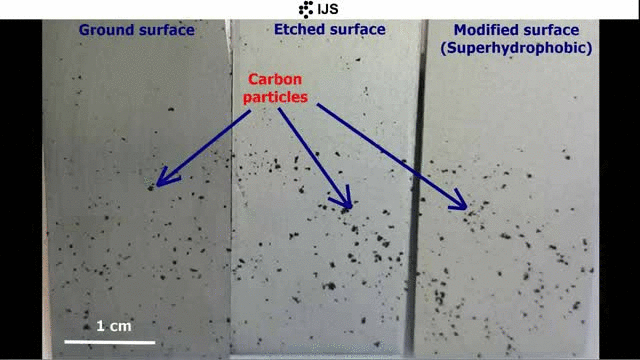Research programme
Corrosion protection
In the field of corrosion protection our research is focused on the following topics:
Superhydrophobic, self-cleaning and anti-icing coatings
In general, a superhydrophilic surface has contact angle of liquid drop θ < 10°, a hydrophilic surface has 10° < θ < 90° , and hydrophobic 90° < θ < 150°. Superhydrophobic surfaces, i.e., those which have a tendency to repel water drops, are characterized by a high apparent contact angle, ( θ > 150°), low contact angle hysteresis (<10°), and low sliding angle (α < 5°). The interest in superhydrophobic surfaces has been rising considerably as reflected by numerous review papers published in the last decade. Superhydrophobicity of the surface is achieved by an appropriate combination of surface roughness, texture, and low surface energy.
To produce a superhydrophobic surface usually a two-step process is used. The first step is a mechanical modification, i.e. extensive roughening of the surface under alkaline or acid etching aiming to produce protrusions at the surface which would allow the formation of Cassie-Baxter regime. The second step is the chemical modification, i.e. coverage of the rough surface by compound of a low surface energy. These compounds usually include long chain alkyl-, silane- or fluorinated compounds. As these chemicals are slightly soluble in water, the immersion is usually carried out in their ethanol solution.
Superhydrophobic materials are useful in various industrial and every-day applications, for example as water repellent surfaces, anti-icing, self-cleaning, anti-fogging, anti-fouling, etc.

Publications related to superhydrophobic, self-cleaning and anti-icing coatings
P. Rodič, M. Može, I. Golobič, I. Milošev, Metals, 2024, 14, 10, art. 1118, 1–20.
P. Rodič, N. Kovač, S. Kralj, S. Jereb, I. Golobič, M. Može, I. Milošev, Surf. Coat. Technol., 2024, 494, art. 131325, 1–15.
P. Rodič, B. Kapun, I. Milošev, Molecules, 2022, 27, 1099-1–1099-19.
P. Rodič, B. Kapun, M. Panjan, I. Milošev, Coatings, 2020, 10, 234-1–234-21.
P. Rodič, I. Milošev, Surf. Coat. Technol., 2019, 369, 175–185.
I. Milošev, T. Kosec, M. Bele, J. Appl. Electrochem., 2010, 40, 1317–1323.
T. Kosec, A. Legat, I. Milošev, Prog. Org. Coat., 2010, 69, 199–206.
Projects related to superhydrophobic, self-cleaning and anti-icing coatings
Micro Grant of KET4CP Hydrophobic top coat for marine applications, partners International Iberian Nanotechnology Laboratory (IBN) and ChemiTek, Portugal, project leader: dr. Ingrid Milošev duration: 1.4.–1.10.2019
M-ERA.NET Transnational call 2014 Design of corrosion resistant coatings targeted for versatile applications«, acronym COR_ID, coordinator dr. Ingrid Milošev, 2016–2019
